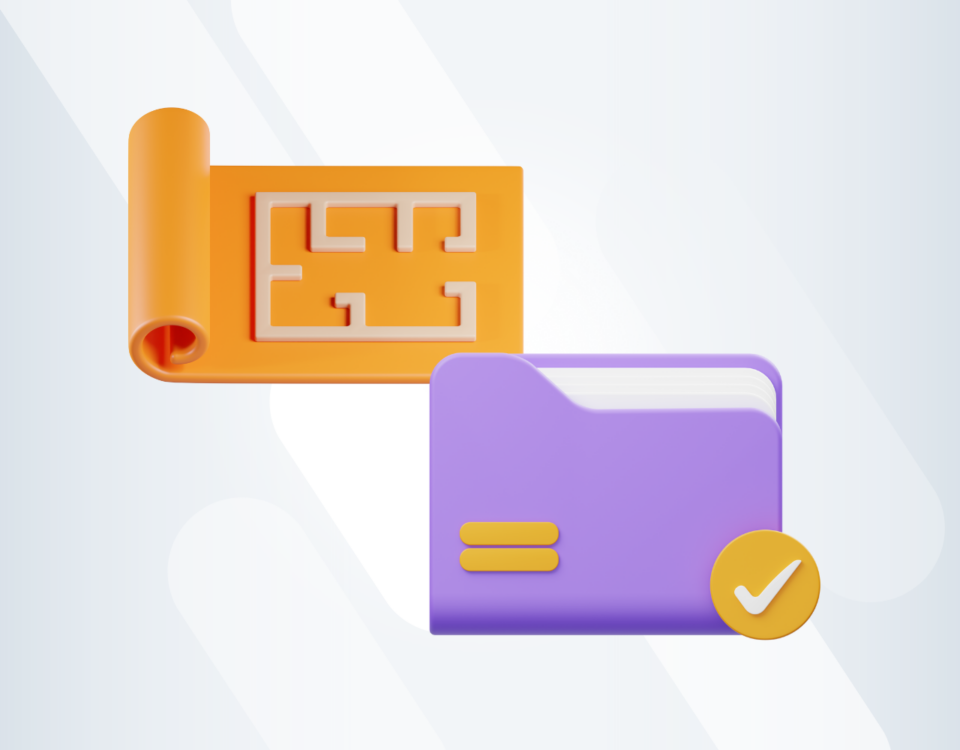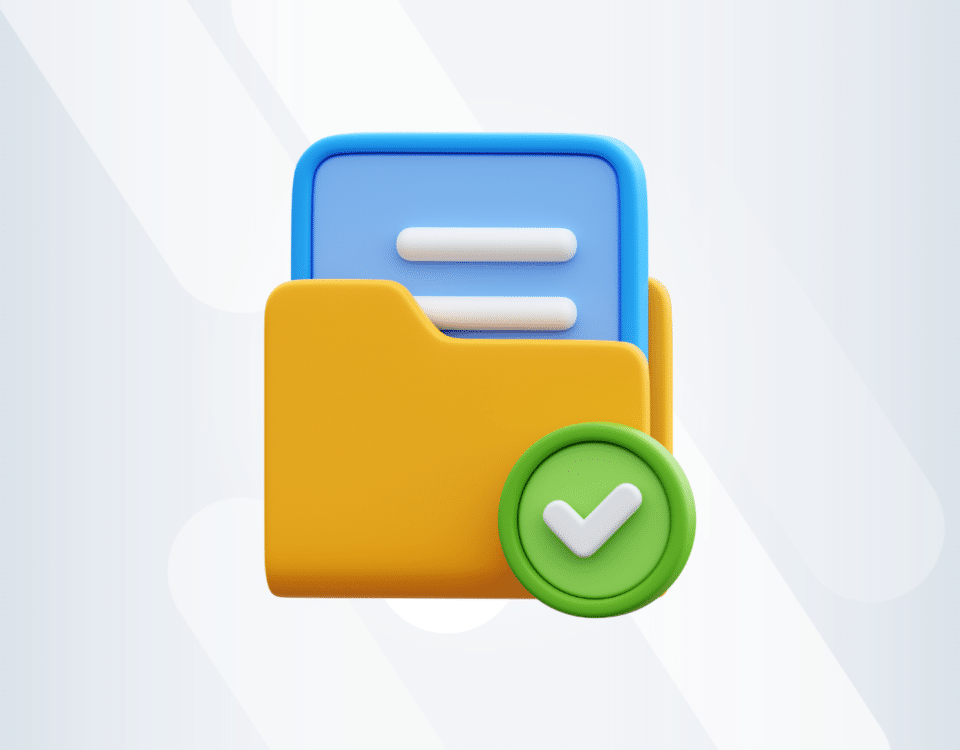Construction Tips, News & Best Practices
Construction Invoicing 101: Best Practices and Billing Procedures
An Essential Guide with 6 Free Templates(2023)
Nobody wants to spend hours digging through job orders and purchase reports, but an effective construction invoice is the key to keeping your construction business profitable.
If you’re already a pro and want to jump straight to finding the right tool – check out our recent look through the runners and riders for the best construction invoicing software.
Click here If you want to skip straight to our free construction invoice templates.
Picture this: you’ve been working on a construction project and you’re days away from completion.
After 6 months of blood, sweat and painful negotiations with subcontractors, you’re looking forward to cashing in your paycheck, having a well-deserved break and looking forward to your next contract.
But there’s one slight issue. The client hasn’t yet paid their dues and you’re increasingly beginning to wonder whether they’re actually going to.
The thing is, it’s a bit late to un-build the house now, isn’t it?
This is the nightmare of every construction business owner: when the work’s done and you're still waiting to get paid. For small firms, it could mean the end of your business.
So, what’s the solution? The trick is to make sure your back is covered before the construction project starts.
And to do that, you need to get to grips with how to create a construction invoice.
Construction billing basics (with construction invoice templates)
Construction invoices are documents that contractors use to work out how much money they’re owed by their clients and when those costs should be paid.
As we’ll discover, there are several ways to price up a construction invoice. Each project is its own unique beast, so coming up with a one-size fits all sample construction invoice is a fool’s errand.
That being said, we’ve never been averse to a bit of light foolishness so let’s give it a try anyway.
Depending on the kind of project you’re working on, here’s a list of the types of information you might be looking to collect on your construction invoice:
- Name of the project
- Name of the client
- Name of the contractor
- Invoice date and number
- Project details
- Payment terms and conditions
- Total amount due
- Total value of work to date
- Costs remaining
- List of work completed, percentage completion or relevant milestones reached
- Costs of services, building materials, labour or others
- Any relevant change orders
- Any costs being retained by the client until completion (known as ‘retainage’)
- Details of any previous payments
If you want to see how these are represented on actual invoices, take a look through some of our construction invoice templates.
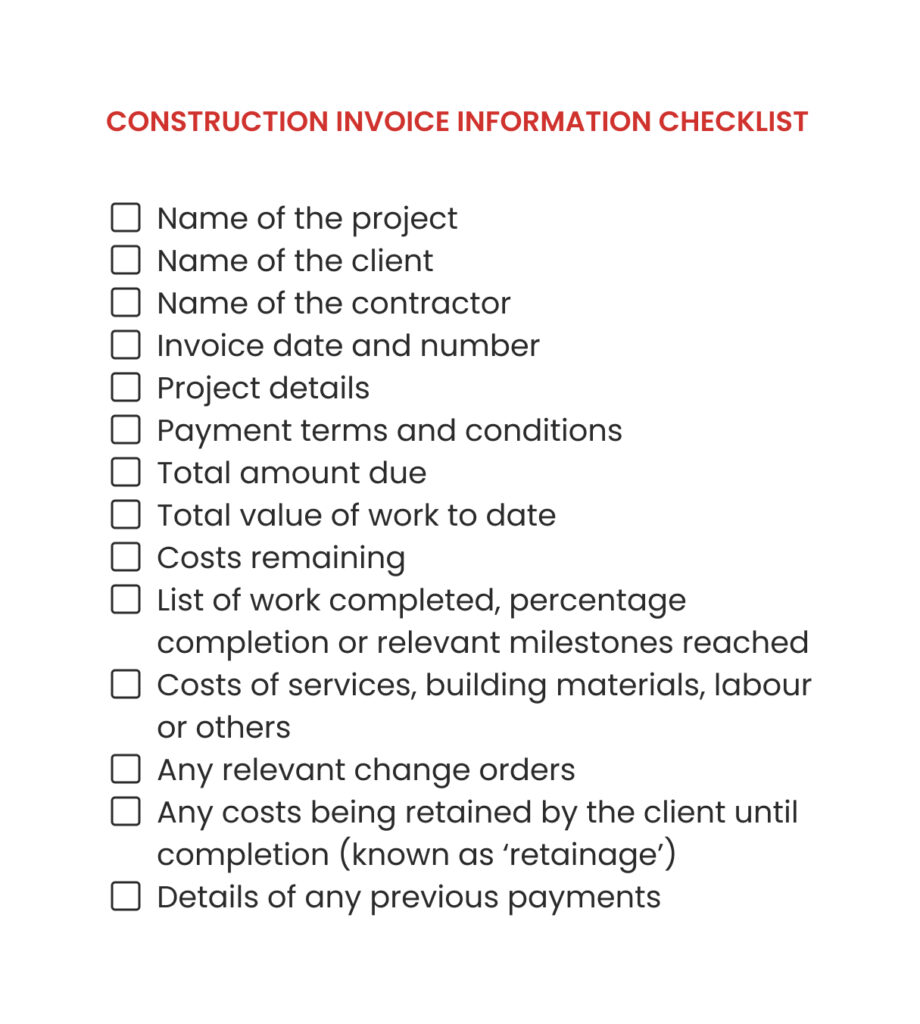
You won’t need all of these details in every type of invoice, but some are universal.
You’re not going to get far without, for instance, your name and the client’s - regardless of how and when they’re paying…
But the importance of percentage completion, costs of services or outstanding balance very much depends on how many instalments you’ll be paid in and how they’re calculated.
And since we’ve so neatly landed on the topic, what better time to dig into some of those invoicing methods? So, buckle in - because we’re about to talk billing.
Types of construction invoice
To understand how a construction invoice works, we first need to drill down into the different ways projects are charged and why you might choose each option:
1) Lump sum/Fixed-price
This does what it says on the tin.
A set price is agreed upon and paid in a single instalment – either before the project begins or after completion. This is best for fairly short-term projects with predictable costs.
Pros: Simple to invoice and pay. There’s no need to worry about progress-based billing and there’s less need to scrupulously track all your costs and materials.
Cons: If charged at the end of the project, you could end up out of pocket if the client doesn’t pay up.
It also leaves you with hefty bills if costs exceed your expectations – so this isn’t a good option for complex or unpredictable projects.

2) Progress-based billing
Progress-based billing is a little more complex – because it’s designed to spread your income over the length of a project.
To do that, the percentage completion method is used to calculate costs.
For example, if 30% of a project is complete in a month, you will get 30% of the total job cost in that period.
Check out our recent deep dive into work-in-progress reporting to find out more.
Pros: Helps you spread your costs over the length of a project and reduces the financial risk of long, complex projects.
It’s designed to closely tie your income to your costs, reducing volatility.
Cons: It can be time-consuming and complicated to get right and requires a scrupulous record of all costs.
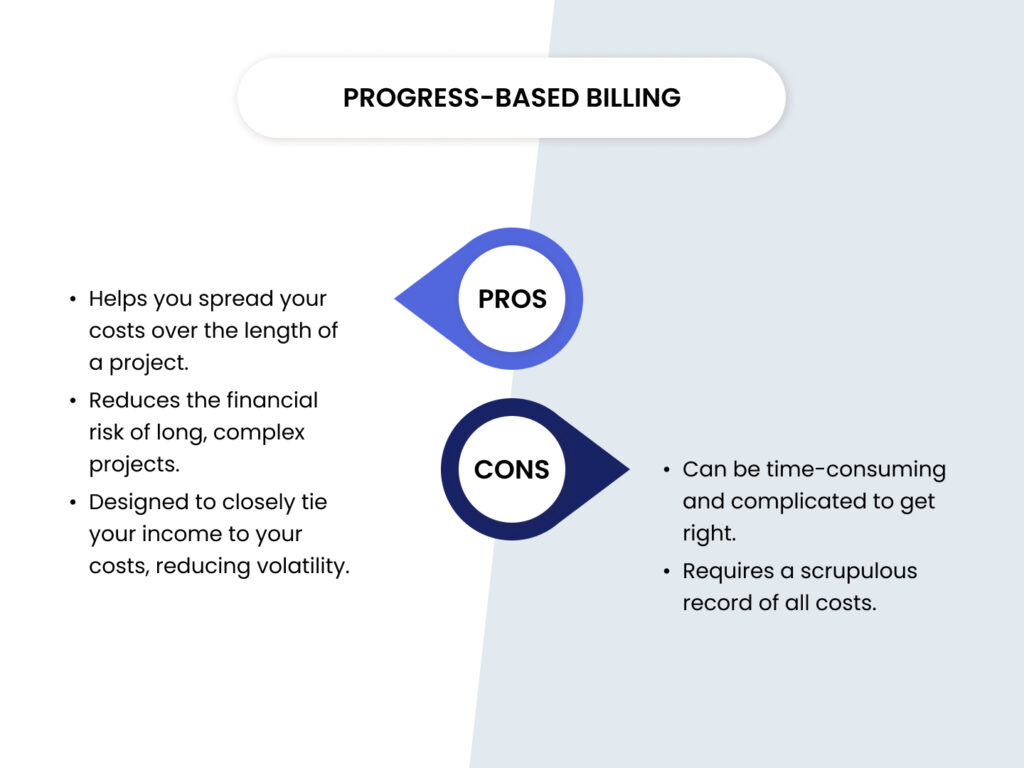
3) Milestone-based billing
Similar to progress-based billing, this is another way of spreading costs and payments over a project.
The difference here is that clients are charged when pre-agreed milestones (set at the start of the project) are complete.
Pros: As with progress-based billing, this helps spread your payments.
It also requires less admin, since there isn't such a need to document each individual material purchased and hour worked.
Cons: This system can be rigid if requirements or scope changes.
If a particular milestone is no longer needed or if one stage takes longer than necessary, you could end up waiting longer for payment than you expected.
You also need to be very clear with the client what constitutes a milestone and who signs that off – as it could lead to disputes later down the line.
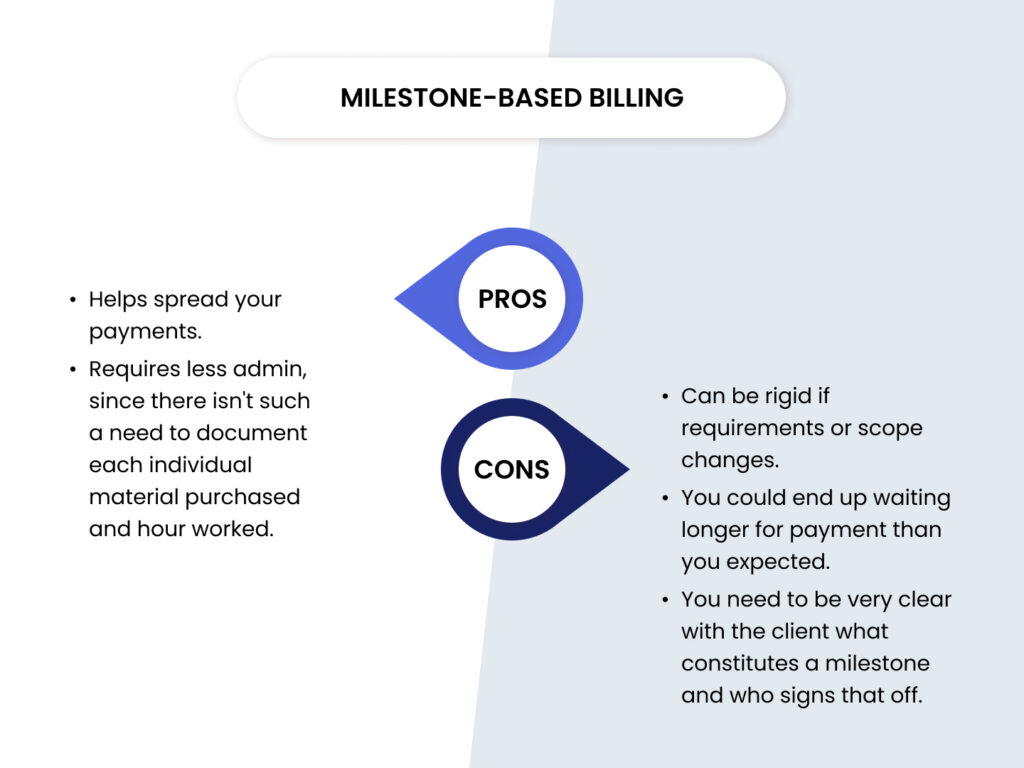
4) Time and Materials
This is more common in domestic contracts.
Here, the contractor will charge the client's account directly for any materials and simply add a standard hourly/daily rate on top for their labour.
Pros: This means you’re not liable for the cost of materials and don’t have to fund the project if those costs rise unexpectedly.
It also protects you from the financial risk created by change orders and scope creep, as any additional charges are passed onto the customer.
Cons: It requires a lot of admin as you’ll have to track all material costs.
It could also create stress down the line as customers paying for materials can occasionally have unhelpful or inconvenient views on which to use.
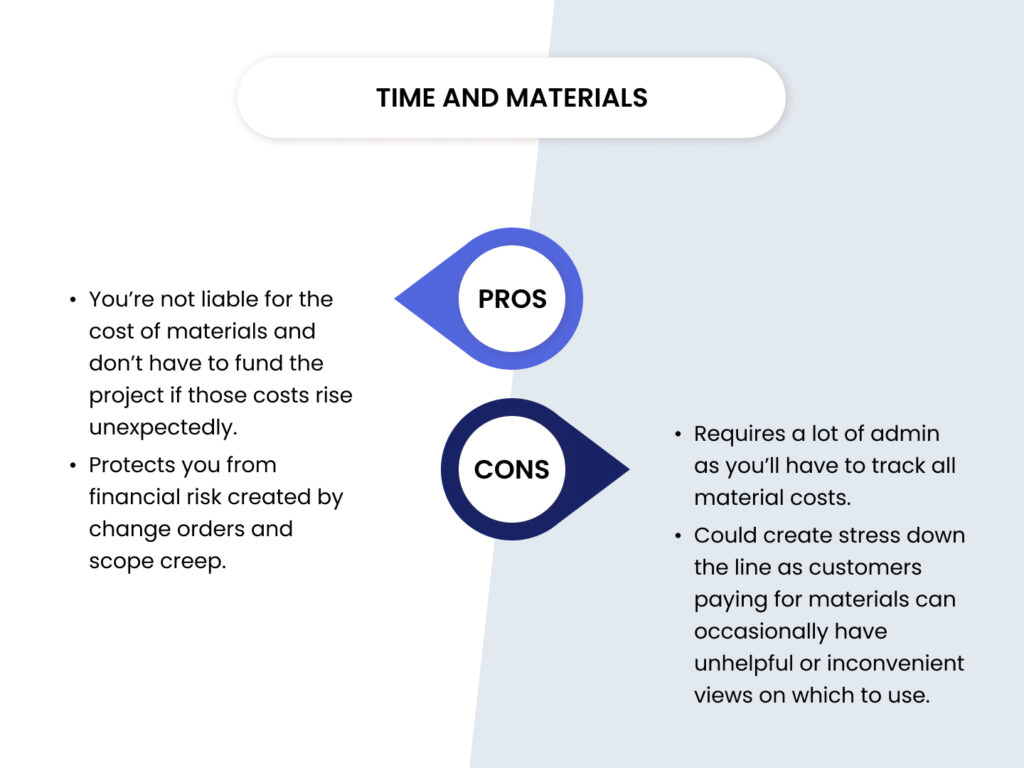
5) Costs plus percentage/fee
Similar to the last example, all costs are again passed onto the customers here.
The big difference is that you don’t charge for the hours worked, you instead add a set or percentage fee - usually based on the size or value of the property.
The pros and cons are almost identical to time and materials here – the only difference is how your fee is charged.
Best practices for construction invoicing success
The goal for your invoice is clear: get paid the right amount, at the right time. But if your processes aren’t clear, you and the client might end up with very different ideas of the payment due date and amount - which isn’t ideal.
So, if you want to avoid disputes over costs, project delays or other misunderstandings – here are a few tips to help keep you (and, most importantly, your clients…) in check:
1) Maintain accurate records
You need a clear data trail of every pound spent, hour worked and agreement made – so you can prove you’re in the right if confusion occurs.
2) Consistent formatting
If all your invoices are consistent in format, it’s a lot easier to avoid errors and easily compare information from multiple billing periods.
3) Establish clear payment terms
Whichever billing method you choose, you and your client need to be clear exactly when payment will be made and how it will be calculated.
Leave no room for ambiguity – it could haunt you later.
4) Use clear and detailed descriptions
You’d be shocked to hear how many disputes occur because of a simple misprint or miscommunication.
Create clear payment instructions and terms on your documents, so mistakes aren’t allowed to sneak in.
5) Use the right technology
Getting construction invoices right requires detailed records, lots of information and, occasionally, a bit of maths.
We’re not saying you can’t do that on Excel, but if you value your free time and sanity, you’re much better off with a specialist construction accounting software tool. More on that below.
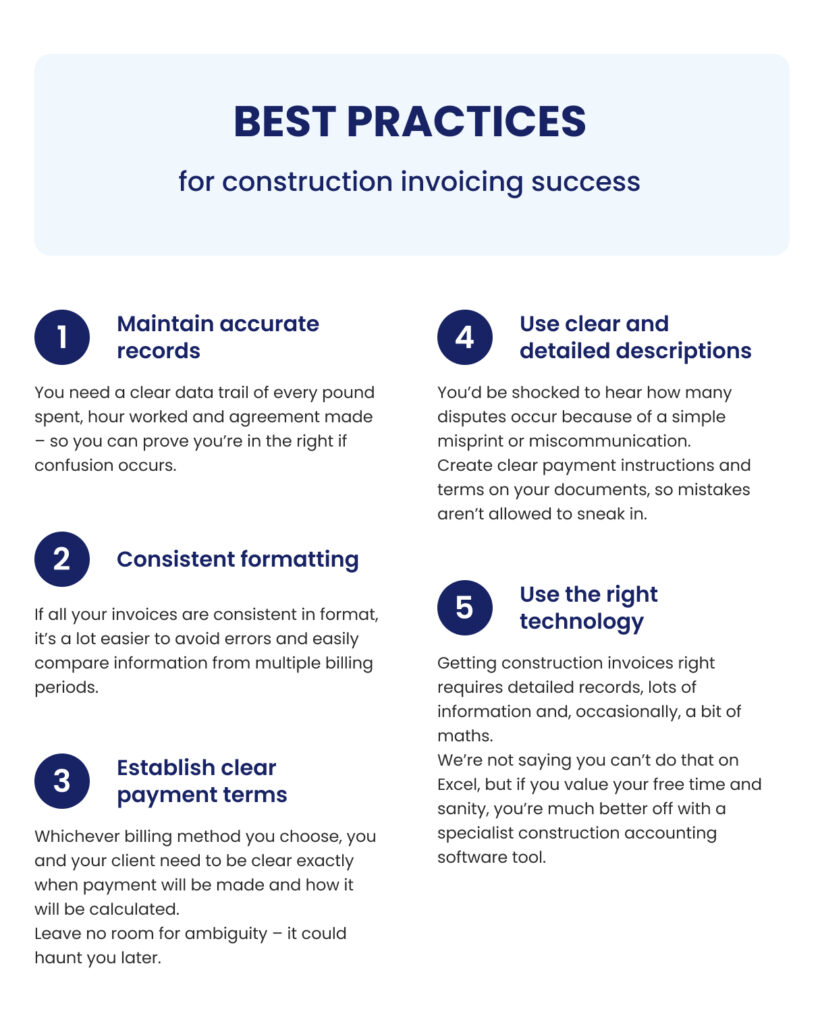
We ask ChatGPT: How to solve the biggest construction invoice problems
At Archdesk, we spend a lot of time speaking to construction companies about the challenges they face – not least when it comes to creating effective and professional invoices.
But, crucially, we can only speak to one client at a time.
So, we thought it’d be a potentially fun and interesting exercise to cast the net a little wider and see exactly how many opinions and examples we can analyse in one go.
To do that, we turned to ChatGPT.
After scanning a frankly impressive number of forums, LinkedIn posts and Reddit chats, here’s what ChatGPT discovered to be the construction industry’s biggest challenge:
“I’m tired of dealing with scope creep and change orders.”
I'm sure plenty of construction business owners can happily relate to that one. Done wrong, they can send even the best-planned projects off the rails.
This creates misunderstandings, disputed costs, delays and complications – and nobody wants that.
So, you ask, how can we solve the biggest challenge in the sector? Well, ChatGPT had some pretty helpful words of wisdom about that as well:
- Create a pre-defined approval process for changes
- Communicate clearly between parties about work completed
- Have a separate section in invoices for change-related costs
- Track and monitor change orders using project management software
And since ChatGPT led us so nicely on to the topic…
Archdesk: Construction invoices made simple
Let’s assume for the sake of argument that you don’t have time to manually track every individual hour worked, material purchased and equipment rented.
What construction businesses need is something that can automatically calculate your material costs, hours worked and other expenses, then create accurate, compliant and consistent invoices based on that information.
You may be surprised to hear Archdesk can help you do just that. Here’s how:
- Easily view existing invoices as well as their affiliation, totals and status
- Generate work-in-progress, including costs, hours worked and expenses
- Create a simple data trail of all invoices, sales and purchase orders, so you’re never on the back foot
- Reduce the risk of mistakes or confusion with construction-specific accounting tools
- Integrate easily with external accounting systems like Xero or Quickbooks
And just for a bit of extra fun, we asked ChatGPT to round us off by saying something nice about Archdesk:
“Kudos to the Archdesk team for their hard work and dedication in providing such a valuable resource to the construction industry!”
Well, if ChatGPT says it’s true…
Want to find out more? Request a demo today.
Frequently Asked Questions: Achieving construction invoice success
1. How to do an invoice for construction
To create a construction invoice, you will need to include as standard the name of the project, client, contractor, invoice date & number, project details, T&Cs and monies owed. Depending on your billing method, you may need to include other information alongside this.
2. What is the difference between invoicing and billing?
These terms describe the same process, though there are subtle differences. Professional invoices are generally sent to clients for services and bills are sent to customers for products.
3. What is required for a CIS invoice?
A CIS (or construction) invoice form should include your construction business details, client’s information, project details, invoice date & number, list of services/work complete, payment T&Cs and total amount due. Other information may be required depending on the project and your billing procedures.

Danny Mitchell
Head of Content Marketing
You might also like
February 29, 2024 • 7 min read
Utilizing the human-first approach to construction projects to drive higher results.
July 3, 2023 • 6 min read
8 Best Construction Drawing Management Software (2023): A Comprehensive Guide
Find all the information you need about the construction drawing management software tools available on ...June 14, 2023 • 6 min read
The 11 Best PlanGrid Alternatives (2023)
Looking for a great alternative to PlanGrid software? Check out the 11 best construction software tools ...June 14, 2023 • 4 min read
How to win at CIS 340 and make taxes a breeze
CIS 340 is a legal obligation for contractors. But getting it right isn’t straightforward. Want ...



